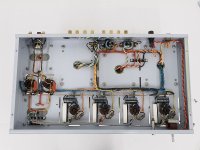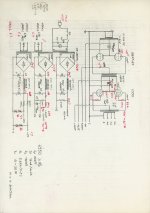I have this vintage Audio Tekne power amp from Japan. There’s distortion in the left channel. Swapping tubes does not change anything. The distortion remains on the left channel.
This is fine. I’ve been told it’s likely a bad resistor. Seeing as how I have to take it to a local tech, I thought it may be a good opportunity to improve what I can while I have it with a tech.
First plan is to replace those sandcast resistors with mills resistors(or any recommended resistors of high quality) of higher ohm rating to lower bias and not run these NOS GE 6550 tubes so hard at 90mA even though I’ve read the GE 6550s can handle the high bias.
The point of the question. Does the capacitor on the tube socket make a difference in sound quality? I’ve seen Kondo builds where the electrolytic looks bypassed with a small film cap. Does that mean putting a film capacitor would yield sound changes/improvements easily heard?
This is fine. I’ve been told it’s likely a bad resistor. Seeing as how I have to take it to a local tech, I thought it may be a good opportunity to improve what I can while I have it with a tech.
First plan is to replace those sandcast resistors with mills resistors(or any recommended resistors of high quality) of higher ohm rating to lower bias and not run these NOS GE 6550 tubes so hard at 90mA even though I’ve read the GE 6550s can handle the high bias.
The point of the question. Does the capacitor on the tube socket make a difference in sound quality? I’ve seen Kondo builds where the electrolytic looks bypassed with a small film cap. Does that mean putting a film capacitor would yield sound changes/improvements easily heard?
Attachments
Interesting. So far, i've read it makes more of a difference in the preamp tubes vs the power. I've also just come across wire round resistors. The ones in that gold casing and to use those?I put film bypass caps on those electrolytic caps as a rule of thumb. I really don’t hear a massive difference but there is some in the high end. It’s cheap enough to do and doesn’t hurt.
I would have liked to have kept it Japanese parts only, but idk any Japanese film caps outside of Tone Factory which are hard to come by. Fostex CS series are no longer made. There is urushi capacitors from Feastrex to use small value bypass of the electrolytic. This should be fun. I have Toshiba 6Bx7 tubes incoming from Japan, as well.
@jjasniew Thanks, it is to die for ain’t it? I just gotta clear up that L channel distortion. Biggest transformers I’ve seen. I have the matching all transformer coupled preamp as well both straight from Japan used market and just yesterday arrived carbon feet for both amps and a freshly built Audio Tekne (117v:100v) ALT-8905 transformer. The power amp is definitely louder and more dynamic with a lot more bass direct to wall via a variac transformer, but designer and owner Imai San says it will take time to get used to the quieter softer sound without distortion.
Attachments
You may need an oscilloscope to chase a signal through the offending side. Or, a PC with REW and a USB sound card will do, with the caveat you'd need some Probe circuitry before the card inputs to be able to just connect it up "anywhere" in that amp. Ideally, both left and right channels would be accommodated. Then you could go node against node for Left and Right, compare waveforms. I think REW will even generate the test signal for you.I just gotta clear up that L channel distortion. Biggest transformers I’ve seen. I have the matching all transformer coupled preamp as well both straight from Japan used market
You'd need a little something resistor wise to put on the amplifier outputs instead of your speakers, before putting a test signal through the amp. I assume the distortion can be heard at low volume levels? REW could display the difference between L and R.
Used market, eh? Makes me wonder who'd give it up and why. A NON-transformer coupled aficionado! Or couldnt afford to keep it for the sound.
Those wirewound resistors can be inductive. They make non inductive ones too. If it is made by Dale, the RN Series is what you want. They must be mounted to a heat sink to get rated power and the cases are not connected to the internals so you can use the chassis as a sink.
You have one bad sounding channel, and one good sounding channel.
And, you are considering changing some parts to get better sound.
The first rule of changing parts, modifying, etc. is:
Fix the bad channel first . . .
and then make the changes you are wanting to do.
Just my opinion.
And, you are considering changing some parts to get better sound.
The first rule of changing parts, modifying, etc. is:
Fix the bad channel first . . .
and then make the changes you are wanting to do.
Just my opinion.
- Home
- Amplifiers
- Tubes / Valves
- Help with vintage tube amp parts replacements




